Quick filters:
First mesa hopi Stock Photos and Images
 Hopi atist; Kachina Doll; (Kokopol), Late 19th century, First Mesa, Arizona; Wood, pigment, cotton, feathers, hide, horse hair; Stock Photohttps://www.alamy.com/image-license-details/?v=1https://www.alamy.com/hopi-atist-kachina-doll-kokopol-late-19th-century-first-mesa-arizona-wood-pigment-cotton-feathers-hide-horse-hair-image456094598.html
Hopi atist; Kachina Doll; (Kokopol), Late 19th century, First Mesa, Arizona; Wood, pigment, cotton, feathers, hide, horse hair; Stock Photohttps://www.alamy.com/image-license-details/?v=1https://www.alamy.com/hopi-atist-kachina-doll-kokopol-late-19th-century-first-mesa-arizona-wood-pigment-cotton-feathers-hide-horse-hair-image456094598.htmlRM2HE0W8P–Hopi atist; Kachina Doll; (Kokopol), Late 19th century, First Mesa, Arizona; Wood, pigment, cotton, feathers, hide, horse hair;
![South to the picturesque village of Wolpi [Walpi], first mesa, Hopi Indian Reservation, Arizona, 1900. Stock Photo South to the picturesque village of Wolpi [Walpi], first mesa, Hopi Indian Reservation, Arizona, 1900. Stock Photo](https://c8.alamy.com/comp/K155D6/south-to-the-picturesque-village-of-wolpi-walpi-first-mesa-hopi-indian-K155D6.jpg) South to the picturesque village of Wolpi [Walpi], first mesa, Hopi Indian Reservation, Arizona, 1900. Stock Photohttps://www.alamy.com/image-license-details/?v=1https://www.alamy.com/south-to-the-picturesque-village-of-wolpi-walpi-first-mesa-hopi-indian-image155622018.html
South to the picturesque village of Wolpi [Walpi], first mesa, Hopi Indian Reservation, Arizona, 1900. Stock Photohttps://www.alamy.com/image-license-details/?v=1https://www.alamy.com/south-to-the-picturesque-village-of-wolpi-walpi-first-mesa-hopi-indian-image155622018.htmlRMK155D6–South to the picturesque village of Wolpi [Walpi], first mesa, Hopi Indian Reservation, Arizona, 1900.
 278 South to the picturesque village of Wolpi (Walpi), first mesa, Hopi Indian Reservation, Arizona, by Underwood & Underwood Stock Photohttps://www.alamy.com/image-license-details/?v=1https://www.alamy.com/278-south-to-the-picturesque-village-of-wolpi-walpi-first-mesa-hopi-indian-reservation-arizona-by-underwood-amp-underwood-image208678162.html
278 South to the picturesque village of Wolpi (Walpi), first mesa, Hopi Indian Reservation, Arizona, by Underwood & Underwood Stock Photohttps://www.alamy.com/image-license-details/?v=1https://www.alamy.com/278-south-to-the-picturesque-village-of-wolpi-walpi-first-mesa-hopi-indian-reservation-arizona-by-underwood-amp-underwood-image208678162.htmlRMP3E33E–278 South to the picturesque village of Wolpi (Walpi), first mesa, Hopi Indian Reservation, Arizona, by Underwood & Underwood
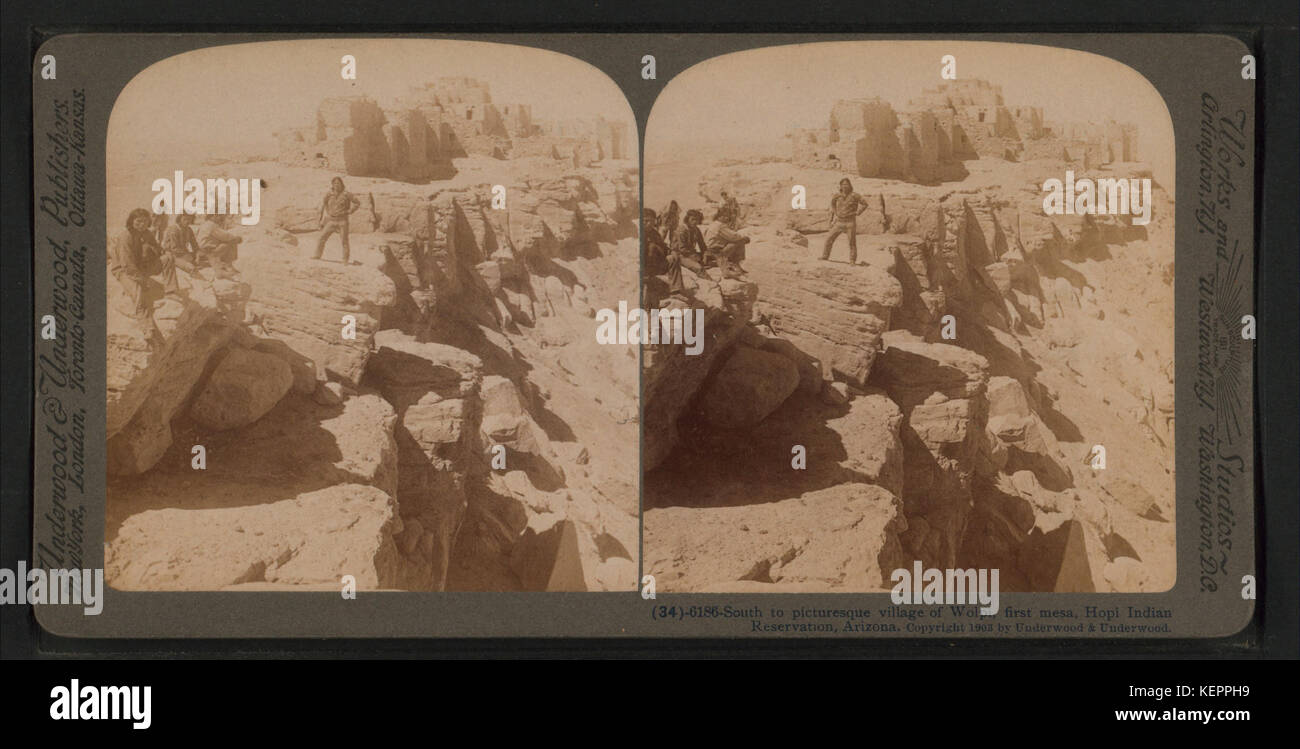 South to the picturesque village of Wolpi (Walpi), first mesa, Hopi Indian Reservation, Arizona, by Underwood & Underwood Stock Photohttps://www.alamy.com/image-license-details/?v=1https://www.alamy.com/stock-image-south-to-the-picturesque-village-of-wolpi-walpi-first-mesa-hopi-indian-163999173.html
South to the picturesque village of Wolpi (Walpi), first mesa, Hopi Indian Reservation, Arizona, by Underwood & Underwood Stock Photohttps://www.alamy.com/image-license-details/?v=1https://www.alamy.com/stock-image-south-to-the-picturesque-village-of-wolpi-walpi-first-mesa-hopi-indian-163999173.htmlRMKEPPH9–South to the picturesque village of Wolpi (Walpi), first mesa, Hopi Indian Reservation, Arizona, by Underwood & Underwood
 South to the picturesque village of Wolpi (Walpi), first mesa, Hopi Indian Reservation, Arizona, by Underwood & Underwood Stock Photohttps://www.alamy.com/image-license-details/?v=1https://www.alamy.com/south-to-the-picturesque-village-of-wolpi-walpi-first-mesa-hopi-indian-reservation-arizona-by-underwood-underwood-image260052462.html
South to the picturesque village of Wolpi (Walpi), first mesa, Hopi Indian Reservation, Arizona, by Underwood & Underwood Stock Photohttps://www.alamy.com/image-license-details/?v=1https://www.alamy.com/south-to-the-picturesque-village-of-wolpi-walpi-first-mesa-hopi-indian-reservation-arizona-by-underwood-underwood-image260052462.htmlRMW32BFX–South to the picturesque village of Wolpi (Walpi), first mesa, Hopi Indian Reservation, Arizona, by Underwood & Underwood
 Walpi, Hopi Pueblo, Arizona, about 1872. Walpi is a Hopi village established around 900 AD, located east of the Grand Canyon in Navajo County, northern Arizona. Walpi is the Hopi term for 'place of the notch.' Historically, the village has also been known as Ash Hill Terrace, Gaspe, Gualpi, Hualpi, Kuchapturela, Valpee, and Wolpi. Walpi became the official name as a result of a decision of the Board on Geographic Names in 1915. Walpi is an ancient stone pueblo complex located on the First Mesa (of three), 300 feet (91 m) above the canyon floor, on the Hopi Reservation. Stock Photohttps://www.alamy.com/image-license-details/?v=1https://www.alamy.com/walpi-hopi-pueblo-arizona-about-1872-walpi-is-a-hopi-village-established-around-900-ad-located-east-of-the-grand-canyon-in-navajo-county-northern-arizona-walpi-is-the-hopi-term-for-place-of-the-notch-historically-the-village-has-also-been-known-as-ash-hill-terrace-gaspe-gualpi-hualpi-kuchapturela-valpee-and-wolpi-walpi-became-the-official-name-as-a-result-of-a-decision-of-the-board-on-geographic-names-in-1915-walpi-is-an-ancient-stone-pueblo-complex-located-on-the-first-mesa-of-three-300-feet-91-m-above-the-canyon-floor-on-the-hopi-reservation-image246611595.html
Walpi, Hopi Pueblo, Arizona, about 1872. Walpi is a Hopi village established around 900 AD, located east of the Grand Canyon in Navajo County, northern Arizona. Walpi is the Hopi term for 'place of the notch.' Historically, the village has also been known as Ash Hill Terrace, Gaspe, Gualpi, Hualpi, Kuchapturela, Valpee, and Wolpi. Walpi became the official name as a result of a decision of the Board on Geographic Names in 1915. Walpi is an ancient stone pueblo complex located on the First Mesa (of three), 300 feet (91 m) above the canyon floor, on the Hopi Reservation. Stock Photohttps://www.alamy.com/image-license-details/?v=1https://www.alamy.com/walpi-hopi-pueblo-arizona-about-1872-walpi-is-a-hopi-village-established-around-900-ad-located-east-of-the-grand-canyon-in-navajo-county-northern-arizona-walpi-is-the-hopi-term-for-place-of-the-notch-historically-the-village-has-also-been-known-as-ash-hill-terrace-gaspe-gualpi-hualpi-kuchapturela-valpee-and-wolpi-walpi-became-the-official-name-as-a-result-of-a-decision-of-the-board-on-geographic-names-in-1915-walpi-is-an-ancient-stone-pueblo-complex-located-on-the-first-mesa-of-three-300-feet-91-m-above-the-canyon-floor-on-the-hopi-reservation-image246611595.htmlRMT963GY–Walpi, Hopi Pueblo, Arizona, about 1872. Walpi is a Hopi village established around 900 AD, located east of the Grand Canyon in Navajo County, northern Arizona. Walpi is the Hopi term for 'place of the notch.' Historically, the village has also been known as Ash Hill Terrace, Gaspe, Gualpi, Hualpi, Kuchapturela, Valpee, and Wolpi. Walpi became the official name as a result of a decision of the Board on Geographic Names in 1915. Walpi is an ancient stone pueblo complex located on the First Mesa (of three), 300 feet (91 m) above the canyon floor, on the Hopi Reservation.
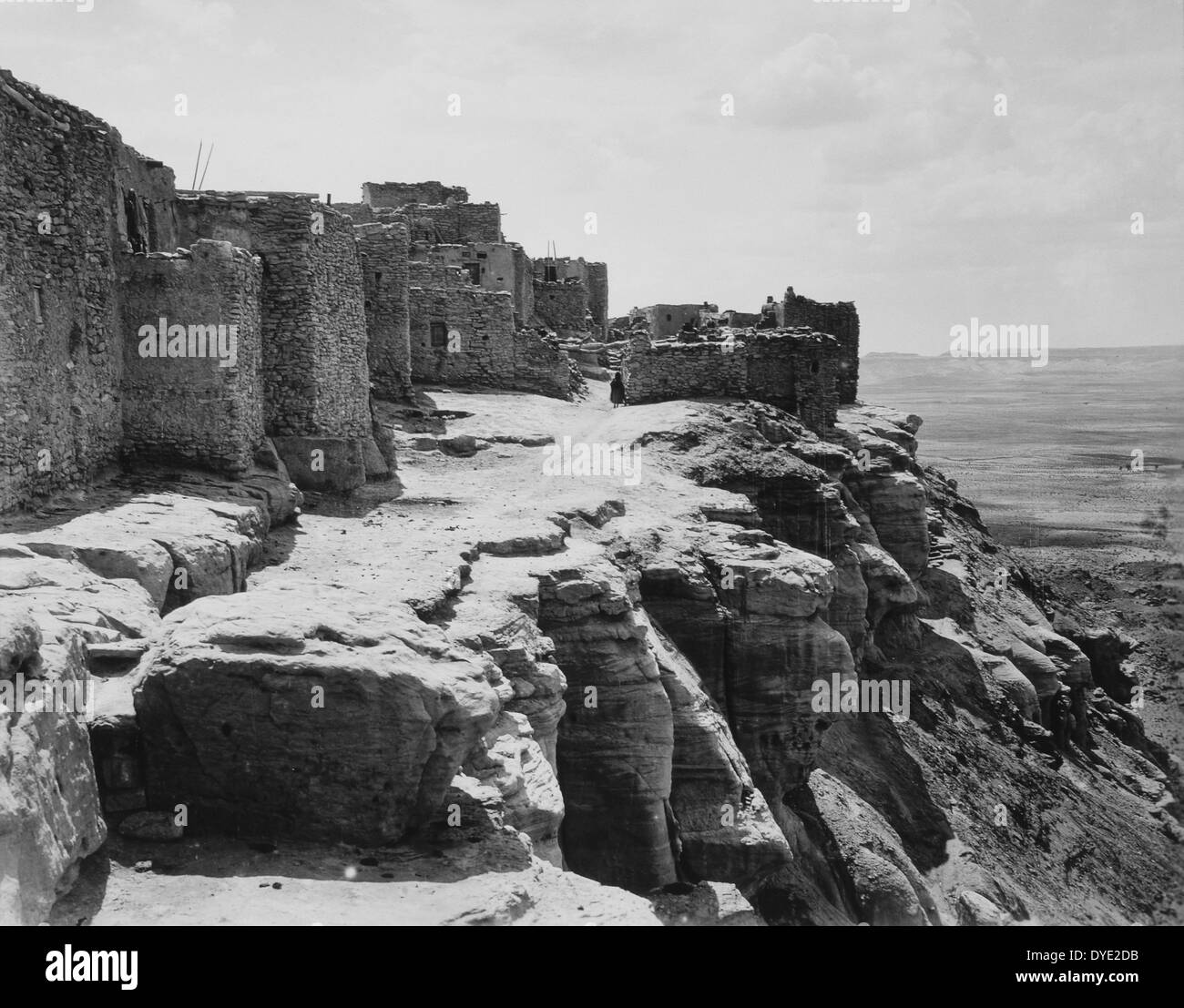 Walpi, Hopi Village on First Mesa, Arizona, USA, circa 1901 Stock Photohttps://www.alamy.com/image-license-details/?v=1https://www.alamy.com/walpi-hopi-village-on-first-mesa-arizona-usa-circa-1901-image68536087.html
Walpi, Hopi Village on First Mesa, Arizona, USA, circa 1901 Stock Photohttps://www.alamy.com/image-license-details/?v=1https://www.alamy.com/walpi-hopi-village-on-first-mesa-arizona-usa-circa-1901-image68536087.htmlRMDYE2DB–Walpi, Hopi Village on First Mesa, Arizona, USA, circa 1901
 Polychrome jar, by Nampeyo, Hopi-Tewa, First Mesa, Arizona, c. 1900-1920 Stock Photohttps://www.alamy.com/image-license-details/?v=1https://www.alamy.com/polychrome-jar-by-nampeyo-hopi-tewa-first-mesa-arizona-c-1900-1920-image344339735.html
Polychrome jar, by Nampeyo, Hopi-Tewa, First Mesa, Arizona, c. 1900-1920 Stock Photohttps://www.alamy.com/image-license-details/?v=1https://www.alamy.com/polychrome-jar-by-nampeyo-hopi-tewa-first-mesa-arizona-c-1900-1920-image344339735.htmlRM2B060RK–Polychrome jar, by Nampeyo, Hopi-Tewa, First Mesa, Arizona, c. 1900-1920
 First published 1916 Hopi Indian tribe Pale Horse rider Village of Walapai Arizona Stock Photohttps://www.alamy.com/image-license-details/?v=1https://www.alamy.com/stock-photo-first-published-1916-hopi-indian-tribe-pale-horse-rider-village-of-47509891.html
First published 1916 Hopi Indian tribe Pale Horse rider Village of Walapai Arizona Stock Photohttps://www.alamy.com/image-license-details/?v=1https://www.alamy.com/stock-photo-first-published-1916-hopi-indian-tribe-pale-horse-rider-village-of-47509891.htmlRMCN879R–First published 1916 Hopi Indian tribe Pale Horse rider Village of Walapai Arizona
 East side of First Mesa (East Mesa) from the southeast trail to the Hopi pueblo of Walpi, Arizona, ca.1898 Stock Photohttps://www.alamy.com/image-license-details/?v=1https://www.alamy.com/east-side-of-first-mesa-east-mesa-from-the-southeast-trail-to-the-hopi-pueblo-of-walpi-arizona-ca1898-image265053811.html
East side of First Mesa (East Mesa) from the southeast trail to the Hopi pueblo of Walpi, Arizona, ca.1898 Stock Photohttps://www.alamy.com/image-license-details/?v=1https://www.alamy.com/east-side-of-first-mesa-east-mesa-from-the-southeast-trail-to-the-hopi-pueblo-of-walpi-arizona-ca1898-image265053811.htmlRMWB66RF–East side of First Mesa (East Mesa) from the southeast trail to the Hopi pueblo of Walpi, Arizona, ca.1898
 Vessel, early 20th century, 3 3/4 x 11 1/2 in. (9.53 x 29.21 cm), Ceramic, pigment, United States, 20th century, The Hopituh Shinumu (Hopi) have a long tradition of making pottery. The quality and creativity of pottery design had reached a peak in the ancient town of Sikyatki between the 14th and 17th century. By the time the former Indian Agent and Englishman, Thomas Keam set up a trading post in Hopituh Shinumu territory in 1875, pottery had declined and many were making white-slipped vessels with A'shiwi (Zuni)-inspired decoration. Stock Photohttps://www.alamy.com/image-license-details/?v=1https://www.alamy.com/vessel-early-20th-century-3-34-x-11-12-in-953-x-2921-cm-ceramic-pigment-united-states-20th-century-the-hopituh-shinumu-hopi-have-a-long-tradition-of-making-pottery-the-quality-and-creativity-of-pottery-design-had-reached-a-peak-in-the-ancient-town-of-sikyatki-between-the-14th-and-17th-century-by-the-time-the-former-indian-agent-and-englishman-thomas-keam-set-up-a-trading-post-in-hopituh-shinumu-territory-in-1875-pottery-had-declined-and-many-were-making-white-slipped-vessels-with-ashiwi-zuni-inspired-decoration-image573505227.html
Vessel, early 20th century, 3 3/4 x 11 1/2 in. (9.53 x 29.21 cm), Ceramic, pigment, United States, 20th century, The Hopituh Shinumu (Hopi) have a long tradition of making pottery. The quality and creativity of pottery design had reached a peak in the ancient town of Sikyatki between the 14th and 17th century. By the time the former Indian Agent and Englishman, Thomas Keam set up a trading post in Hopituh Shinumu territory in 1875, pottery had declined and many were making white-slipped vessels with A'shiwi (Zuni)-inspired decoration. Stock Photohttps://www.alamy.com/image-license-details/?v=1https://www.alamy.com/vessel-early-20th-century-3-34-x-11-12-in-953-x-2921-cm-ceramic-pigment-united-states-20th-century-the-hopituh-shinumu-hopi-have-a-long-tradition-of-making-pottery-the-quality-and-creativity-of-pottery-design-had-reached-a-peak-in-the-ancient-town-of-sikyatki-between-the-14th-and-17th-century-by-the-time-the-former-indian-agent-and-englishman-thomas-keam-set-up-a-trading-post-in-hopituh-shinumu-territory-in-1875-pottery-had-declined-and-many-were-making-white-slipped-vessels-with-ashiwi-zuni-inspired-decoration-image573505227.htmlRM2T91BNF–Vessel, early 20th century, 3 3/4 x 11 1/2 in. (9.53 x 29.21 cm), Ceramic, pigment, United States, 20th century, The Hopituh Shinumu (Hopi) have a long tradition of making pottery. The quality and creativity of pottery design had reached a peak in the ancient town of Sikyatki between the 14th and 17th century. By the time the former Indian Agent and Englishman, Thomas Keam set up a trading post in Hopituh Shinumu territory in 1875, pottery had declined and many were making white-slipped vessels with A'shiwi (Zuni)-inspired decoration.
 Children on the steps of the southeast trail to the Hopi pueblo of Walpi, on the First Mesa, Arizona, ca.1898 Stock Photohttps://www.alamy.com/image-license-details/?v=1https://www.alamy.com/children-on-the-steps-of-the-southeast-trail-to-the-hopi-pueblo-of-image66389864.html
Children on the steps of the southeast trail to the Hopi pueblo of Walpi, on the First Mesa, Arizona, ca.1898 Stock Photohttps://www.alamy.com/image-license-details/?v=1https://www.alamy.com/children-on-the-steps-of-the-southeast-trail-to-the-hopi-pueblo-of-image66389864.htmlRMDT08XG–Children on the steps of the southeast trail to the Hopi pueblo of Walpi, on the First Mesa, Arizona, ca.1898
 Polychrome Jar, c. 1920. Hopi, First Mesa, Arizona. Stock Photohttps://www.alamy.com/image-license-details/?v=1https://www.alamy.com/polychrome-jar-c-1920-hopi-first-mesa-arizona-image453133148.html
Polychrome Jar, c. 1920. Hopi, First Mesa, Arizona. Stock Photohttps://www.alamy.com/image-license-details/?v=1https://www.alamy.com/polychrome-jar-c-1920-hopi-first-mesa-arizona-image453133148.htmlRM2H95YXM–Polychrome Jar, c. 1920. Hopi, First Mesa, Arizona.
 American Indians : first families of the Southwest . liJ HIOD<Q QZ< iij I H0 CL O I r 4 Digitized by Microsoft® Home Sites Miles From Wood and Water In other days the Hopi, centuries ago, built their homes on the tops of themost inaccessible mesas. It meant defense and protection for them, but it alsomeant hardship, for they were far from wood and water. To this day they live inthese fastnesses and the women toil up the steep mesa, carrying water from thesprings far down in the valley. The men go miles for wood and sometimes keeptheir herds at some distance from their mountain homes. The Stock Photohttps://www.alamy.com/image-license-details/?v=1https://www.alamy.com/american-indians-first-families-of-the-southwest-lij-hiodltq-qzlt-iij-i-h0-cl-o-i-r-4-digitized-by-microsoft-home-sites-miles-from-wood-and-water-in-other-days-the-hopi-centuries-ago-built-their-homes-on-the-tops-of-themost-inaccessible-mesas-it-meant-defense-and-protection-for-them-but-it-alsomeant-hardship-for-they-were-far-from-wood-and-water-to-this-day-they-live-inthese-fastnesses-and-the-women-toil-up-the-steep-mesa-carrying-water-from-thesprings-far-down-in-the-valley-the-men-go-miles-for-wood-and-sometimes-keeptheir-herds-at-some-distance-from-their-mountain-homes-the-image343405122.html
American Indians : first families of the Southwest . liJ HIOD<Q QZ< iij I H0 CL O I r 4 Digitized by Microsoft® Home Sites Miles From Wood and Water In other days the Hopi, centuries ago, built their homes on the tops of themost inaccessible mesas. It meant defense and protection for them, but it alsomeant hardship, for they were far from wood and water. To this day they live inthese fastnesses and the women toil up the steep mesa, carrying water from thesprings far down in the valley. The men go miles for wood and sometimes keeptheir herds at some distance from their mountain homes. The Stock Photohttps://www.alamy.com/image-license-details/?v=1https://www.alamy.com/american-indians-first-families-of-the-southwest-lij-hiodltq-qzlt-iij-i-h0-cl-o-i-r-4-digitized-by-microsoft-home-sites-miles-from-wood-and-water-in-other-days-the-hopi-centuries-ago-built-their-homes-on-the-tops-of-themost-inaccessible-mesas-it-meant-defense-and-protection-for-them-but-it-alsomeant-hardship-for-they-were-far-from-wood-and-water-to-this-day-they-live-inthese-fastnesses-and-the-women-toil-up-the-steep-mesa-carrying-water-from-thesprings-far-down-in-the-valley-the-men-go-miles-for-wood-and-sometimes-keeptheir-herds-at-some-distance-from-their-mountain-homes-the-image343405122.htmlRM2AXKCMJ–American Indians : first families of the Southwest . liJ HIOD<Q QZ< iij I H0 CL O I r 4 Digitized by Microsoft® Home Sites Miles From Wood and Water In other days the Hopi, centuries ago, built their homes on the tops of themost inaccessible mesas. It meant defense and protection for them, but it alsomeant hardship, for they were far from wood and water. To this day they live inthese fastnesses and the women toil up the steep mesa, carrying water from thesprings far down in the valley. The men go miles for wood and sometimes keeptheir herds at some distance from their mountain homes. The
![. South to the picturesque village of Wolpi [Walpi], first mesa, Hopi Indian Reservation, Arizona. Coverage: 1870?-1910?. Digital item published 6-30-2005; updated 2-12-2009. 278 South to the picturesque village of Wolpi (Walpi), first mesa, Hopi Indian Reservation, Arizona, by Underwood & Underwood Stock Photo . South to the picturesque village of Wolpi [Walpi], first mesa, Hopi Indian Reservation, Arizona. Coverage: 1870?-1910?. Digital item published 6-30-2005; updated 2-12-2009. 278 South to the picturesque village of Wolpi (Walpi), first mesa, Hopi Indian Reservation, Arizona, by Underwood & Underwood Stock Photo](https://c8.alamy.com/comp/P3E331/south-to-the-picturesque-village-of-wolpi-walpi-first-mesa-hopi-indian-reservation-arizona-coverage-1870-1910-digital-item-published-6-30-2005-updated-2-12-2009-278-south-to-the-picturesque-village-of-wolpi-walpi-first-mesa-hopi-indian-reservation-arizona-by-underwood-amp-underwood-P3E331.jpg) . South to the picturesque village of Wolpi [Walpi], first mesa, Hopi Indian Reservation, Arizona. Coverage: 1870?-1910?. Digital item published 6-30-2005; updated 2-12-2009. 278 South to the picturesque village of Wolpi (Walpi), first mesa, Hopi Indian Reservation, Arizona, by Underwood & Underwood Stock Photohttps://www.alamy.com/image-license-details/?v=1https://www.alamy.com/south-to-the-picturesque-village-of-wolpi-walpi-first-mesa-hopi-indian-reservation-arizona-coverage-1870-1910-digital-item-published-6-30-2005-updated-2-12-2009-278-south-to-the-picturesque-village-of-wolpi-walpi-first-mesa-hopi-indian-reservation-arizona-by-underwood-amp-underwood-image208678149.html
. South to the picturesque village of Wolpi [Walpi], first mesa, Hopi Indian Reservation, Arizona. Coverage: 1870?-1910?. Digital item published 6-30-2005; updated 2-12-2009. 278 South to the picturesque village of Wolpi (Walpi), first mesa, Hopi Indian Reservation, Arizona, by Underwood & Underwood Stock Photohttps://www.alamy.com/image-license-details/?v=1https://www.alamy.com/south-to-the-picturesque-village-of-wolpi-walpi-first-mesa-hopi-indian-reservation-arizona-coverage-1870-1910-digital-item-published-6-30-2005-updated-2-12-2009-278-south-to-the-picturesque-village-of-wolpi-walpi-first-mesa-hopi-indian-reservation-arizona-by-underwood-amp-underwood-image208678149.htmlRMP3E331–. South to the picturesque village of Wolpi [Walpi], first mesa, Hopi Indian Reservation, Arizona. Coverage: 1870?-1910?. Digital item published 6-30-2005; updated 2-12-2009. 278 South to the picturesque village of Wolpi (Walpi), first mesa, Hopi Indian Reservation, Arizona, by Underwood & Underwood
 Children on the steps of the southeast trail to the Hopi pueblo of Walpi, on the First Mesa, Arizona, ca.1898 (CHS 4634) Stock Photohttps://www.alamy.com/image-license-details/?v=1https://www.alamy.com/children-on-the-steps-of-the-southeast-trail-to-the-hopi-pueblo-of-image158883566.html
Children on the steps of the southeast trail to the Hopi pueblo of Walpi, on the First Mesa, Arizona, ca.1898 (CHS 4634) Stock Photohttps://www.alamy.com/image-license-details/?v=1https://www.alamy.com/children-on-the-steps-of-the-southeast-trail-to-the-hopi-pueblo-of-image158883566.htmlRMK6DNH2–Children on the steps of the southeast trail to the Hopi pueblo of Walpi, on the First Mesa, Arizona, ca.1898 (CHS 4634)
![South to the picturesque village of Wolpi (Walpi), first mesa, Hopi Indian Reservation, Arizona South to the picturesque village of Wolpi [Walpi], first mesa, Hopi Indian Reservation, Arizona.; South to the picturesque village of Wolpi [Walpi], first mesa, Hopi Indian Reservation, Arizona. Stock Photo South to the picturesque village of Wolpi (Walpi), first mesa, Hopi Indian Reservation, Arizona South to the picturesque village of Wolpi [Walpi], first mesa, Hopi Indian Reservation, Arizona.; South to the picturesque village of Wolpi [Walpi], first mesa, Hopi Indian Reservation, Arizona. Stock Photo](https://c8.alamy.com/comp/2AKYDN0/south-to-the-picturesque-village-of-wolpi-walpi-first-mesa-hopi-indian-reservation-arizona-south-to-the-picturesque-village-of-wolpi-walpi-first-mesa-hopi-indian-reservation-arizona-south-to-the-picturesque-village-of-wolpi-walpi-first-mesa-hopi-indian-reservation-arizona-2AKYDN0.jpg) South to the picturesque village of Wolpi (Walpi), first mesa, Hopi Indian Reservation, Arizona South to the picturesque village of Wolpi [Walpi], first mesa, Hopi Indian Reservation, Arizona.; South to the picturesque village of Wolpi [Walpi], first mesa, Hopi Indian Reservation, Arizona. Stock Photohttps://www.alamy.com/image-license-details/?v=1https://www.alamy.com/south-to-the-picturesque-village-of-wolpi-walpi-first-mesa-hopi-indian-reservation-arizona-south-to-the-picturesque-village-of-wolpi-walpi-first-mesa-hopi-indian-reservation-arizona-south-to-the-picturesque-village-of-wolpi-walpi-first-mesa-hopi-indian-reservation-arizona-image339278940.html
South to the picturesque village of Wolpi (Walpi), first mesa, Hopi Indian Reservation, Arizona South to the picturesque village of Wolpi [Walpi], first mesa, Hopi Indian Reservation, Arizona.; South to the picturesque village of Wolpi [Walpi], first mesa, Hopi Indian Reservation, Arizona. Stock Photohttps://www.alamy.com/image-license-details/?v=1https://www.alamy.com/south-to-the-picturesque-village-of-wolpi-walpi-first-mesa-hopi-indian-reservation-arizona-south-to-the-picturesque-village-of-wolpi-walpi-first-mesa-hopi-indian-reservation-arizona-south-to-the-picturesque-village-of-wolpi-walpi-first-mesa-hopi-indian-reservation-arizona-image339278940.htmlRM2AKYDN0–South to the picturesque village of Wolpi (Walpi), first mesa, Hopi Indian Reservation, Arizona South to the picturesque village of Wolpi [Walpi], first mesa, Hopi Indian Reservation, Arizona.; South to the picturesque village of Wolpi [Walpi], first mesa, Hopi Indian Reservation, Arizona.
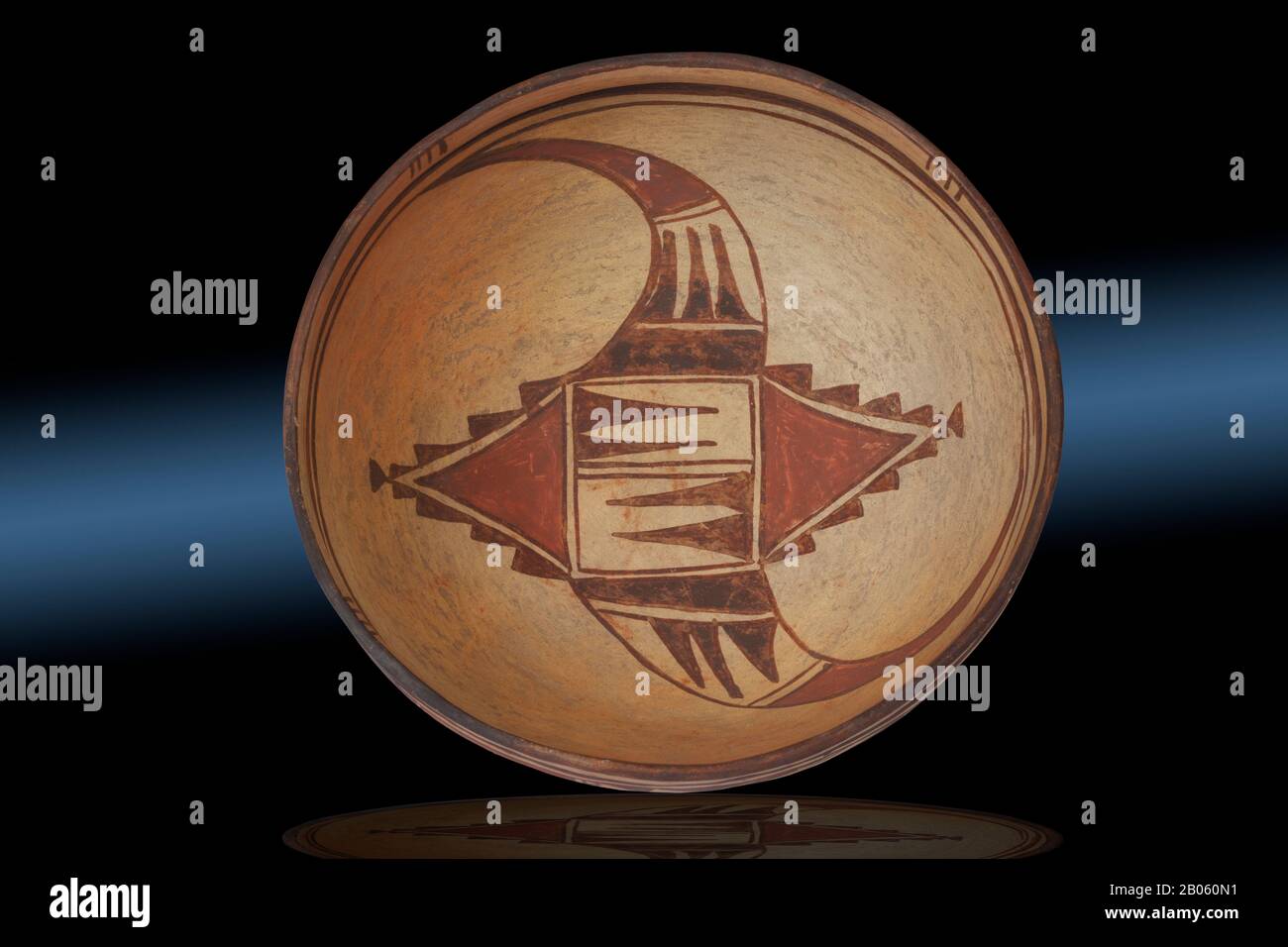 Polychrome Bowl, attributed to Nampeyo, Hopi-Tewa, First Mesa, Arizona, c. 1880-1900 Stock Photohttps://www.alamy.com/image-license-details/?v=1https://www.alamy.com/polychrome-bowl-attributed-to-nampeyo-hopi-tewa-first-mesa-arizona-c-1880-1900-image344339661.html
Polychrome Bowl, attributed to Nampeyo, Hopi-Tewa, First Mesa, Arizona, c. 1880-1900 Stock Photohttps://www.alamy.com/image-license-details/?v=1https://www.alamy.com/polychrome-bowl-attributed-to-nampeyo-hopi-tewa-first-mesa-arizona-c-1880-1900-image344339661.htmlRM2B060N1–Polychrome Bowl, attributed to Nampeyo, Hopi-Tewa, First Mesa, Arizona, c. 1880-1900
 Children on the steps of the southeast trail to the Hopi pueblo of Walpi, on the First Mesa, Arizona, ca.1898 Stock Photohttps://www.alamy.com/image-license-details/?v=1https://www.alamy.com/children-on-the-steps-of-the-southeast-trail-to-the-hopi-pueblo-of-walpi-on-the-first-mesa-arizona-ca1898-image259743538.html
Children on the steps of the southeast trail to the Hopi pueblo of Walpi, on the First Mesa, Arizona, ca.1898 Stock Photohttps://www.alamy.com/image-license-details/?v=1https://www.alamy.com/children-on-the-steps-of-the-southeast-trail-to-the-hopi-pueblo-of-walpi-on-the-first-mesa-arizona-ca1898-image259743538.htmlRMW2G9EX–Children on the steps of the southeast trail to the Hopi pueblo of Walpi, on the First Mesa, Arizona, ca.1898
 East side of First Mesa (East Mesa) from the southeast trail to the Hopi pueblo of Walpi, Arizona, ca.1898 Stock Photohttps://www.alamy.com/image-license-details/?v=1https://www.alamy.com/east-side-of-first-mesa-east-mesa-from-the-southeast-trail-to-the-image66395212.html
East side of First Mesa (East Mesa) from the southeast trail to the Hopi pueblo of Walpi, Arizona, ca.1898 Stock Photohttps://www.alamy.com/image-license-details/?v=1https://www.alamy.com/east-side-of-first-mesa-east-mesa-from-the-southeast-trail-to-the-image66395212.htmlRMDT0FNG–East side of First Mesa (East Mesa) from the southeast trail to the Hopi pueblo of Walpi, Arizona, ca.1898
 Bowl with a Figure Holding a Macaw, 1400/1625. Hopi, First Mesa, Arizona. Stock Photohttps://www.alamy.com/image-license-details/?v=1https://www.alamy.com/bowl-with-a-figure-holding-a-macaw-14001625-hopi-first-mesa-arizona-image453133194.html
Bowl with a Figure Holding a Macaw, 1400/1625. Hopi, First Mesa, Arizona. Stock Photohttps://www.alamy.com/image-license-details/?v=1https://www.alamy.com/bowl-with-a-figure-holding-a-macaw-14001625-hopi-first-mesa-arizona-image453133194.htmlRM2H9600A–Bowl with a Figure Holding a Macaw, 1400/1625. Hopi, First Mesa, Arizona.
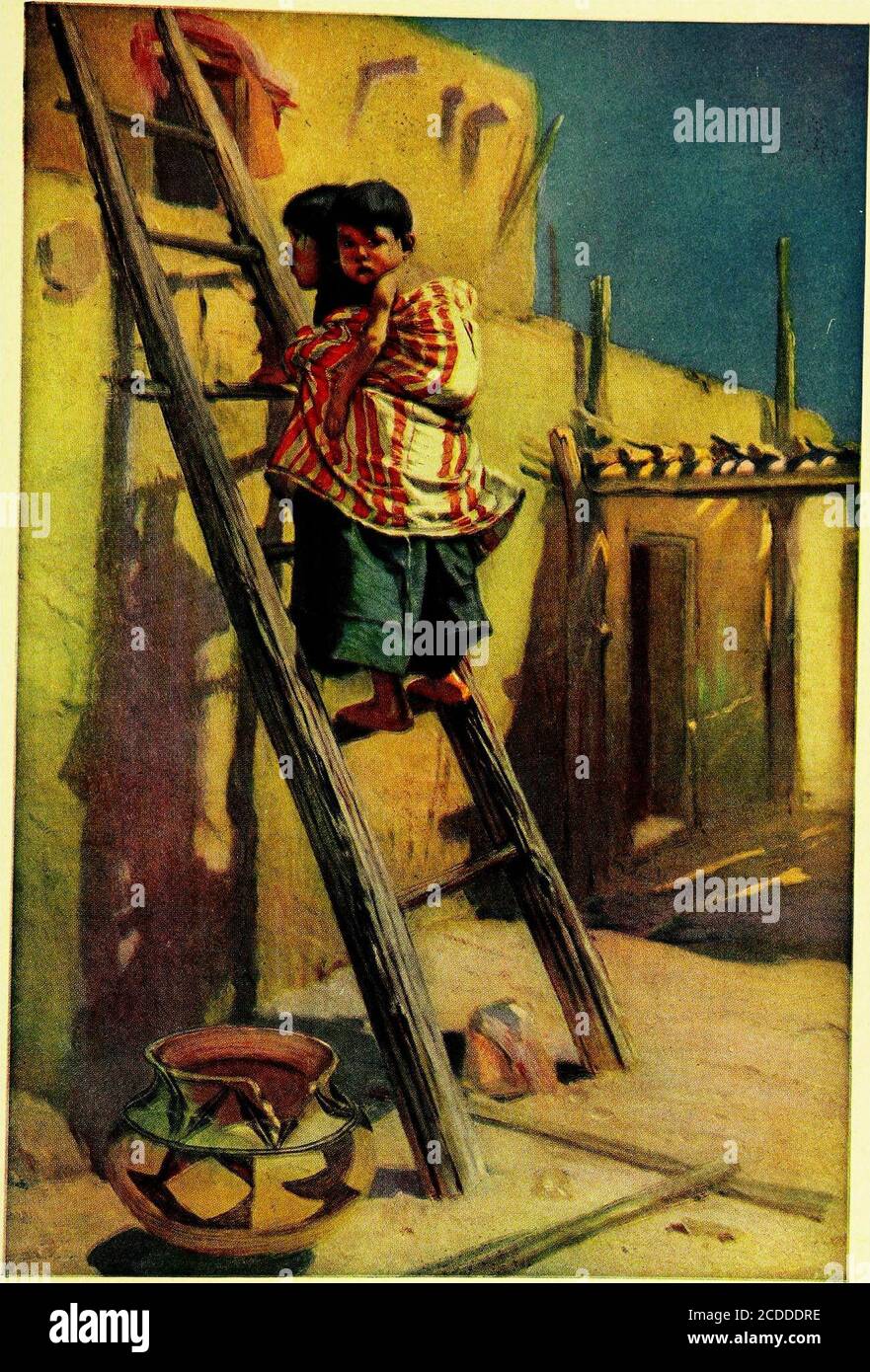 . American Indians : first families of the Southwest . irst story held out. In this store-room corn was stacked up as neatly as cord wood; great earthen-ware vesselscontained the water supply; pumpkins, dried peaches and watermelons wereheaped up for the winter, for the Hopi have always been good farmers and fruitgrowers. The fields and orchards are on the slopes and at the foot of the mesa, asare the springs and as they were centuries ago. The second floor of a Hopi house is usually the living room, with a floor of hardclay, neat and clean; the walls are tinted. Niches in the walls contain ve Stock Photohttps://www.alamy.com/image-license-details/?v=1https://www.alamy.com/american-indians-first-families-of-the-southwest-irst-story-held-out-in-this-store-room-corn-was-stacked-up-as-neatly-as-cord-wood-great-earthen-ware-vesselscontained-the-water-supply-pumpkins-dried-peaches-and-watermelons-wereheaped-up-for-the-winter-for-the-hopi-have-always-been-good-farmers-and-fruitgrowers-the-fields-and-orchards-are-on-the-slopes-and-at-the-foot-of-the-mesa-asare-the-springs-and-as-they-were-centuries-ago-the-second-floor-of-a-hopi-house-is-usually-the-living-room-with-a-floor-of-hardclay-neat-and-clean-the-walls-are-tinted-niches-in-the-walls-contain-ve-image369704482.html
. American Indians : first families of the Southwest . irst story held out. In this store-room corn was stacked up as neatly as cord wood; great earthen-ware vesselscontained the water supply; pumpkins, dried peaches and watermelons wereheaped up for the winter, for the Hopi have always been good farmers and fruitgrowers. The fields and orchards are on the slopes and at the foot of the mesa, asare the springs and as they were centuries ago. The second floor of a Hopi house is usually the living room, with a floor of hardclay, neat and clean; the walls are tinted. Niches in the walls contain ve Stock Photohttps://www.alamy.com/image-license-details/?v=1https://www.alamy.com/american-indians-first-families-of-the-southwest-irst-story-held-out-in-this-store-room-corn-was-stacked-up-as-neatly-as-cord-wood-great-earthen-ware-vesselscontained-the-water-supply-pumpkins-dried-peaches-and-watermelons-wereheaped-up-for-the-winter-for-the-hopi-have-always-been-good-farmers-and-fruitgrowers-the-fields-and-orchards-are-on-the-slopes-and-at-the-foot-of-the-mesa-asare-the-springs-and-as-they-were-centuries-ago-the-second-floor-of-a-hopi-house-is-usually-the-living-room-with-a-floor-of-hardclay-neat-and-clean-the-walls-are-tinted-niches-in-the-walls-contain-ve-image369704482.htmlRM2CDDDRE–. American Indians : first families of the Southwest . irst story held out. In this store-room corn was stacked up as neatly as cord wood; great earthen-ware vesselscontained the water supply; pumpkins, dried peaches and watermelons wereheaped up for the winter, for the Hopi have always been good farmers and fruitgrowers. The fields and orchards are on the slopes and at the foot of the mesa, asare the springs and as they were centuries ago. The second floor of a Hopi house is usually the living room, with a floor of hardclay, neat and clean; the walls are tinted. Niches in the walls contain ve
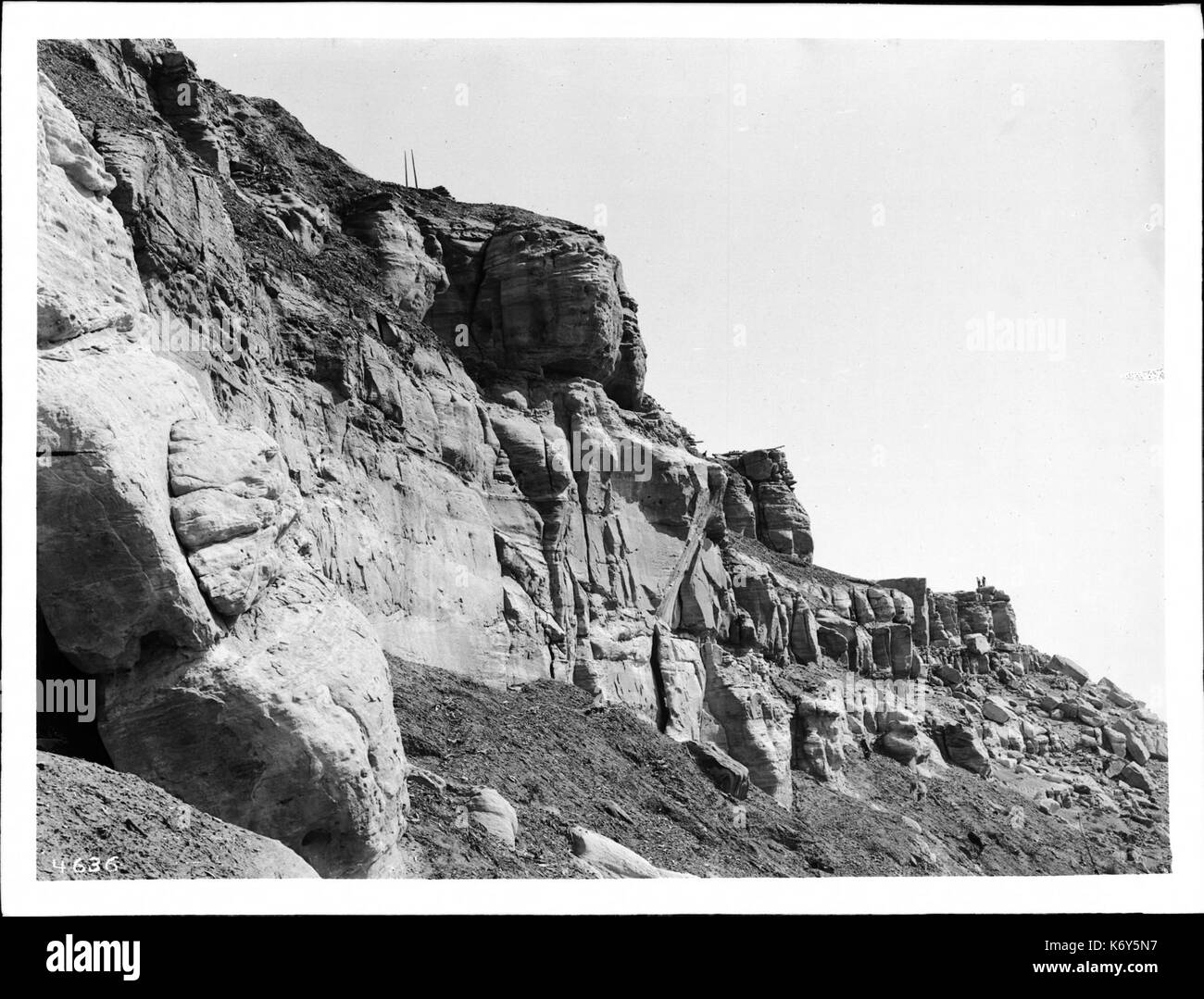 East side of First Mesa (East Mesa) from the southeast trail to the Hopi pueblo of Walpi, Arizona, ca.1898 (CHS 4636) Stock Photohttps://www.alamy.com/image-license-details/?v=1https://www.alamy.com/east-side-of-first-mesa-east-mesa-from-the-southeast-trail-to-the-image159178467.html
East side of First Mesa (East Mesa) from the southeast trail to the Hopi pueblo of Walpi, Arizona, ca.1898 (CHS 4636) Stock Photohttps://www.alamy.com/image-license-details/?v=1https://www.alamy.com/east-side-of-first-mesa-east-mesa-from-the-southeast-trail-to-the-image159178467.htmlRMK6Y5N7–East side of First Mesa (East Mesa) from the southeast trail to the Hopi pueblo of Walpi, Arizona, ca.1898 (CHS 4636)
![South to the picturesque village of Wolpi (Walpi), first mesa, Hopi Indian Reservation, Arizona South to the picturesque village of Wolpi [Walpi], first mesa, Hopi Indian Reservation, Arizona.; South to the picturesque village of Wolpi [Walpi], first mesa, Hopi Indian Reservation, Arizona. Stock Photo South to the picturesque village of Wolpi (Walpi), first mesa, Hopi Indian Reservation, Arizona South to the picturesque village of Wolpi [Walpi], first mesa, Hopi Indian Reservation, Arizona.; South to the picturesque village of Wolpi [Walpi], first mesa, Hopi Indian Reservation, Arizona. Stock Photo](https://c8.alamy.com/comp/2AKYDN8/south-to-the-picturesque-village-of-wolpi-walpi-first-mesa-hopi-indian-reservation-arizona-south-to-the-picturesque-village-of-wolpi-walpi-first-mesa-hopi-indian-reservation-arizona-south-to-the-picturesque-village-of-wolpi-walpi-first-mesa-hopi-indian-reservation-arizona-2AKYDN8.jpg) South to the picturesque village of Wolpi (Walpi), first mesa, Hopi Indian Reservation, Arizona South to the picturesque village of Wolpi [Walpi], first mesa, Hopi Indian Reservation, Arizona.; South to the picturesque village of Wolpi [Walpi], first mesa, Hopi Indian Reservation, Arizona. Stock Photohttps://www.alamy.com/image-license-details/?v=1https://www.alamy.com/south-to-the-picturesque-village-of-wolpi-walpi-first-mesa-hopi-indian-reservation-arizona-south-to-the-picturesque-village-of-wolpi-walpi-first-mesa-hopi-indian-reservation-arizona-south-to-the-picturesque-village-of-wolpi-walpi-first-mesa-hopi-indian-reservation-arizona-image339278948.html
South to the picturesque village of Wolpi (Walpi), first mesa, Hopi Indian Reservation, Arizona South to the picturesque village of Wolpi [Walpi], first mesa, Hopi Indian Reservation, Arizona.; South to the picturesque village of Wolpi [Walpi], first mesa, Hopi Indian Reservation, Arizona. Stock Photohttps://www.alamy.com/image-license-details/?v=1https://www.alamy.com/south-to-the-picturesque-village-of-wolpi-walpi-first-mesa-hopi-indian-reservation-arizona-south-to-the-picturesque-village-of-wolpi-walpi-first-mesa-hopi-indian-reservation-arizona-south-to-the-picturesque-village-of-wolpi-walpi-first-mesa-hopi-indian-reservation-arizona-image339278948.htmlRM2AKYDN8–South to the picturesque village of Wolpi (Walpi), first mesa, Hopi Indian Reservation, Arizona South to the picturesque village of Wolpi [Walpi], first mesa, Hopi Indian Reservation, Arizona.; South to the picturesque village of Wolpi [Walpi], first mesa, Hopi Indian Reservation, Arizona.
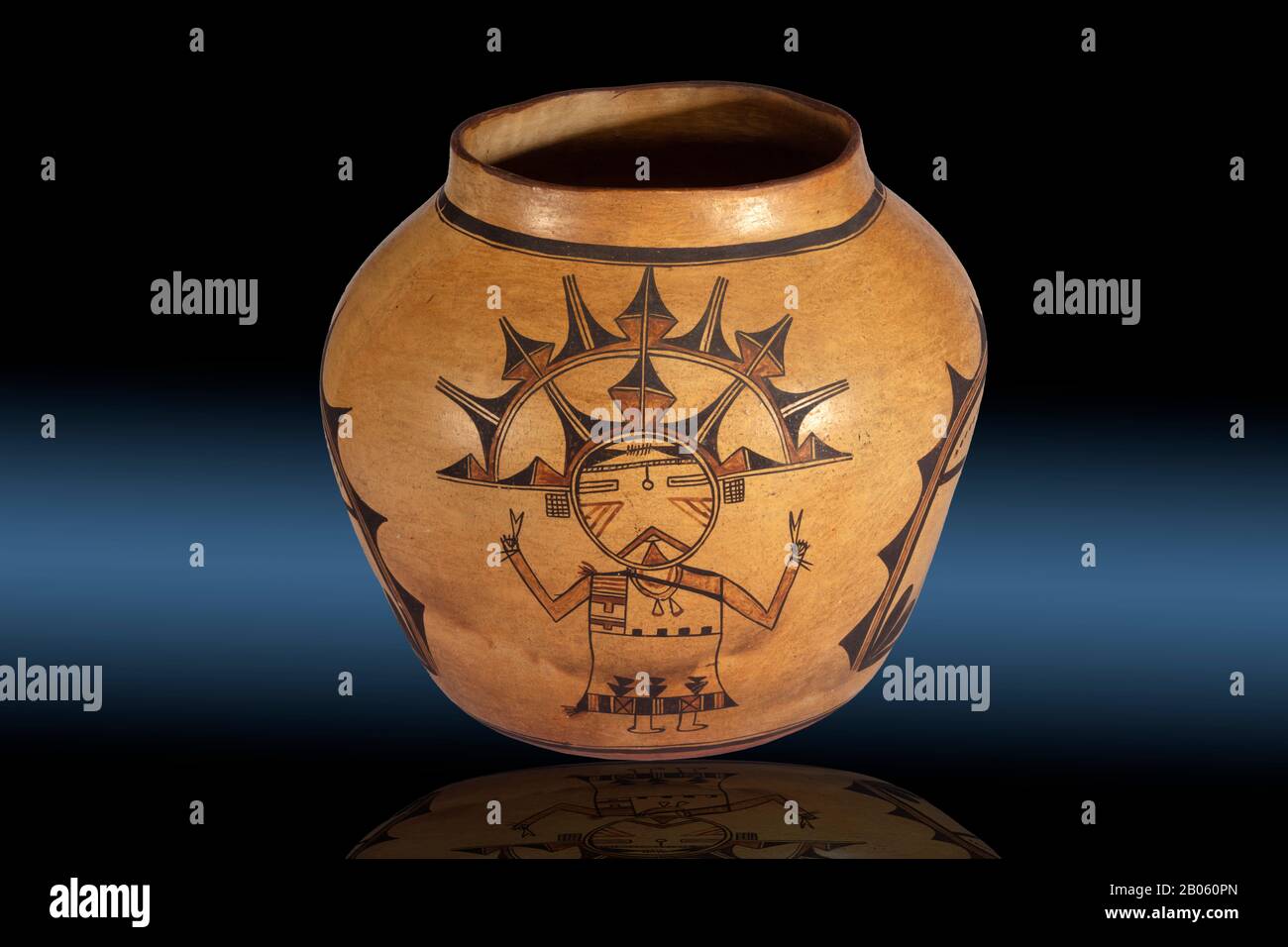 Hopi-Tewa Polacca Polychrome jar with Palhikwmana (Water Drinking Maiden) katsina and unidentified katsina, c. 1890-1900, Katsina Designs, by Nampeyo Stock Photohttps://www.alamy.com/image-license-details/?v=1https://www.alamy.com/hopi-tewa-polacca-polychrome-jar-with-palhikwmana-water-drinking-maiden-katsina-and-unidentified-katsina-c-1890-1900-katsina-designs-by-nampeyo-image344339709.html
Hopi-Tewa Polacca Polychrome jar with Palhikwmana (Water Drinking Maiden) katsina and unidentified katsina, c. 1890-1900, Katsina Designs, by Nampeyo Stock Photohttps://www.alamy.com/image-license-details/?v=1https://www.alamy.com/hopi-tewa-polacca-polychrome-jar-with-palhikwmana-water-drinking-maiden-katsina-and-unidentified-katsina-c-1890-1900-katsina-designs-by-nampeyo-image344339709.htmlRM2B060PN–Hopi-Tewa Polacca Polychrome jar with Palhikwmana (Water Drinking Maiden) katsina and unidentified katsina, c. 1890-1900, Katsina Designs, by Nampeyo
 Mad Stone Eater Kachina, c. 1900. Wooden Kachina doll with pigment and plant fibre. Hopi, First Mesa, Arizona. Stock Photohttps://www.alamy.com/image-license-details/?v=1https://www.alamy.com/mad-stone-eater-kachina-c-1900-wooden-kachina-doll-with-pigment-and-plant-fibre-hopi-first-mesa-arizona-image453133179.html
Mad Stone Eater Kachina, c. 1900. Wooden Kachina doll with pigment and plant fibre. Hopi, First Mesa, Arizona. Stock Photohttps://www.alamy.com/image-license-details/?v=1https://www.alamy.com/mad-stone-eater-kachina-c-1900-wooden-kachina-doll-with-pigment-and-plant-fibre-hopi-first-mesa-arizona-image453133179.htmlRM2H95YYR–Mad Stone Eater Kachina, c. 1900. Wooden Kachina doll with pigment and plant fibre. Hopi, First Mesa, Arizona.
 . Bulletin. Ethnology. 562 HOPI [B. A. E. from the Rio Grande, and Shipaulovi, founded by a colony from Shongopovi on the Second or Middle mesa, are both of comparatively modern origin, having been established about the middle of the 18th century, or about the time the Pay- upki people returned to their old home. Thus the pueblos of the ancient province of Tusayan now consist of the following: Walpi, Sichomovi, and Hano, on the First or East mesa; pop. (1900) 205, 119, and 160, respectively, exclusive of about 20 who have established homes in the plain; total 504. Mishongnovi, Shongo- povi, an Stock Photohttps://www.alamy.com/image-license-details/?v=1https://www.alamy.com/bulletin-ethnology-562-hopi-b-a-e-from-the-rio-grande-and-shipaulovi-founded-by-a-colony-from-shongopovi-on-the-second-or-middle-mesa-are-both-of-comparatively-modern-origin-having-been-established-about-the-middle-of-the-18th-century-or-about-the-time-the-pay-upki-people-returned-to-their-old-home-thus-the-pueblos-of-the-ancient-province-of-tusayan-now-consist-of-the-following-walpi-sichomovi-and-hano-on-the-first-or-east-mesa-pop-1900-205-119-and-160-respectively-exclusive-of-about-20-who-have-established-homes-in-the-plain-total-504-mishongnovi-shongo-povi-an-image234133947.html
. Bulletin. Ethnology. 562 HOPI [B. A. E. from the Rio Grande, and Shipaulovi, founded by a colony from Shongopovi on the Second or Middle mesa, are both of comparatively modern origin, having been established about the middle of the 18th century, or about the time the Pay- upki people returned to their old home. Thus the pueblos of the ancient province of Tusayan now consist of the following: Walpi, Sichomovi, and Hano, on the First or East mesa; pop. (1900) 205, 119, and 160, respectively, exclusive of about 20 who have established homes in the plain; total 504. Mishongnovi, Shongo- povi, an Stock Photohttps://www.alamy.com/image-license-details/?v=1https://www.alamy.com/bulletin-ethnology-562-hopi-b-a-e-from-the-rio-grande-and-shipaulovi-founded-by-a-colony-from-shongopovi-on-the-second-or-middle-mesa-are-both-of-comparatively-modern-origin-having-been-established-about-the-middle-of-the-18th-century-or-about-the-time-the-pay-upki-people-returned-to-their-old-home-thus-the-pueblos-of-the-ancient-province-of-tusayan-now-consist-of-the-following-walpi-sichomovi-and-hano-on-the-first-or-east-mesa-pop-1900-205-119-and-160-respectively-exclusive-of-about-20-who-have-established-homes-in-the-plain-total-504-mishongnovi-shongo-povi-an-image234133947.htmlRMRGWM6K–. Bulletin. Ethnology. 562 HOPI [B. A. E. from the Rio Grande, and Shipaulovi, founded by a colony from Shongopovi on the Second or Middle mesa, are both of comparatively modern origin, having been established about the middle of the 18th century, or about the time the Pay- upki people returned to their old home. Thus the pueblos of the ancient province of Tusayan now consist of the following: Walpi, Sichomovi, and Hano, on the First or East mesa; pop. (1900) 205, 119, and 160, respectively, exclusive of about 20 who have established homes in the plain; total 504. Mishongnovi, Shongo- povi, an
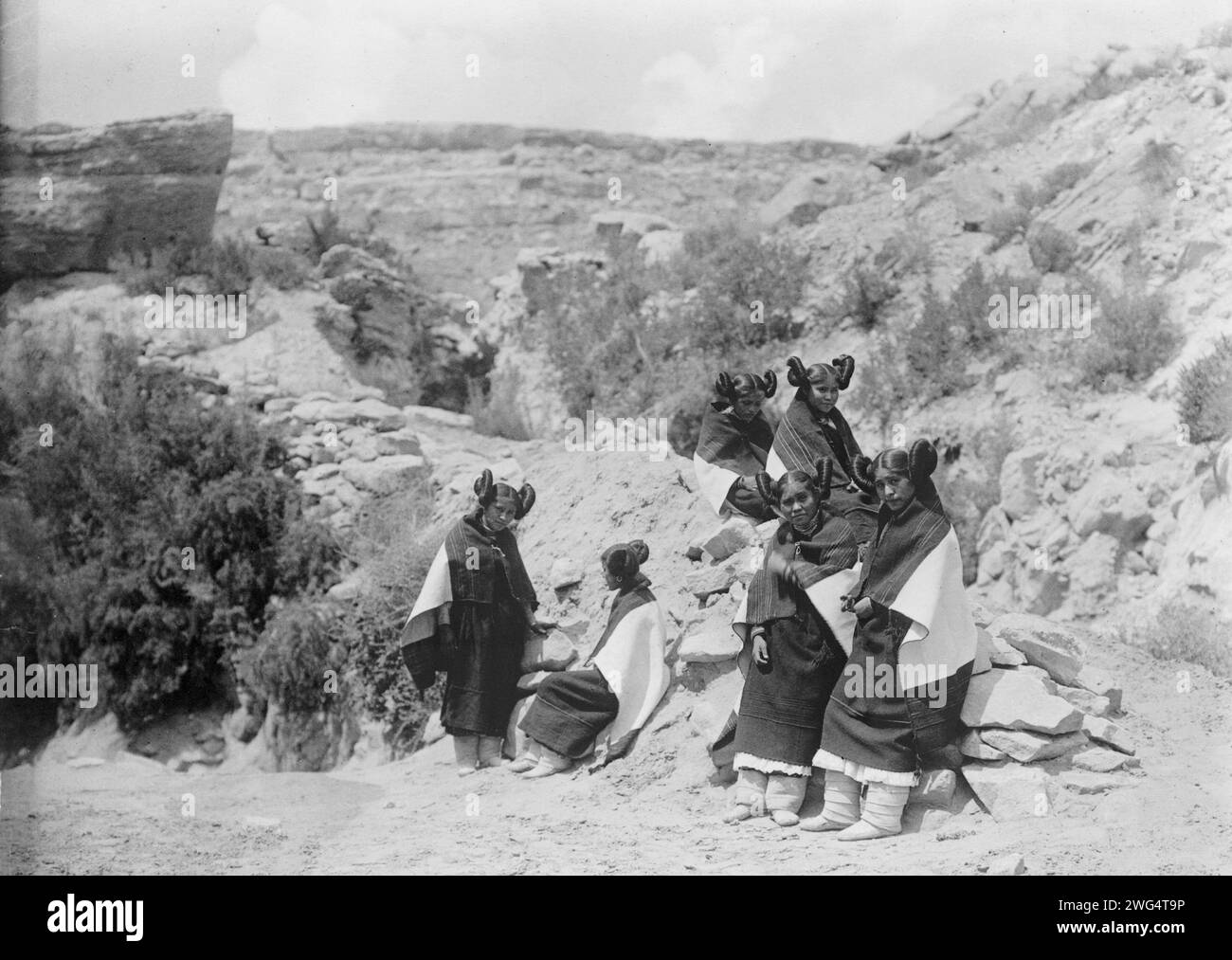 East Mesa girls-Hopi, c1906. Stock Photohttps://www.alamy.com/image-license-details/?v=1https://www.alamy.com/east-mesa-girls-hopi-c1906-image595093906.html
East Mesa girls-Hopi, c1906. Stock Photohttps://www.alamy.com/image-license-details/?v=1https://www.alamy.com/east-mesa-girls-hopi-c1906-image595093906.htmlRM2WG4T9P–East Mesa girls-Hopi, c1906.
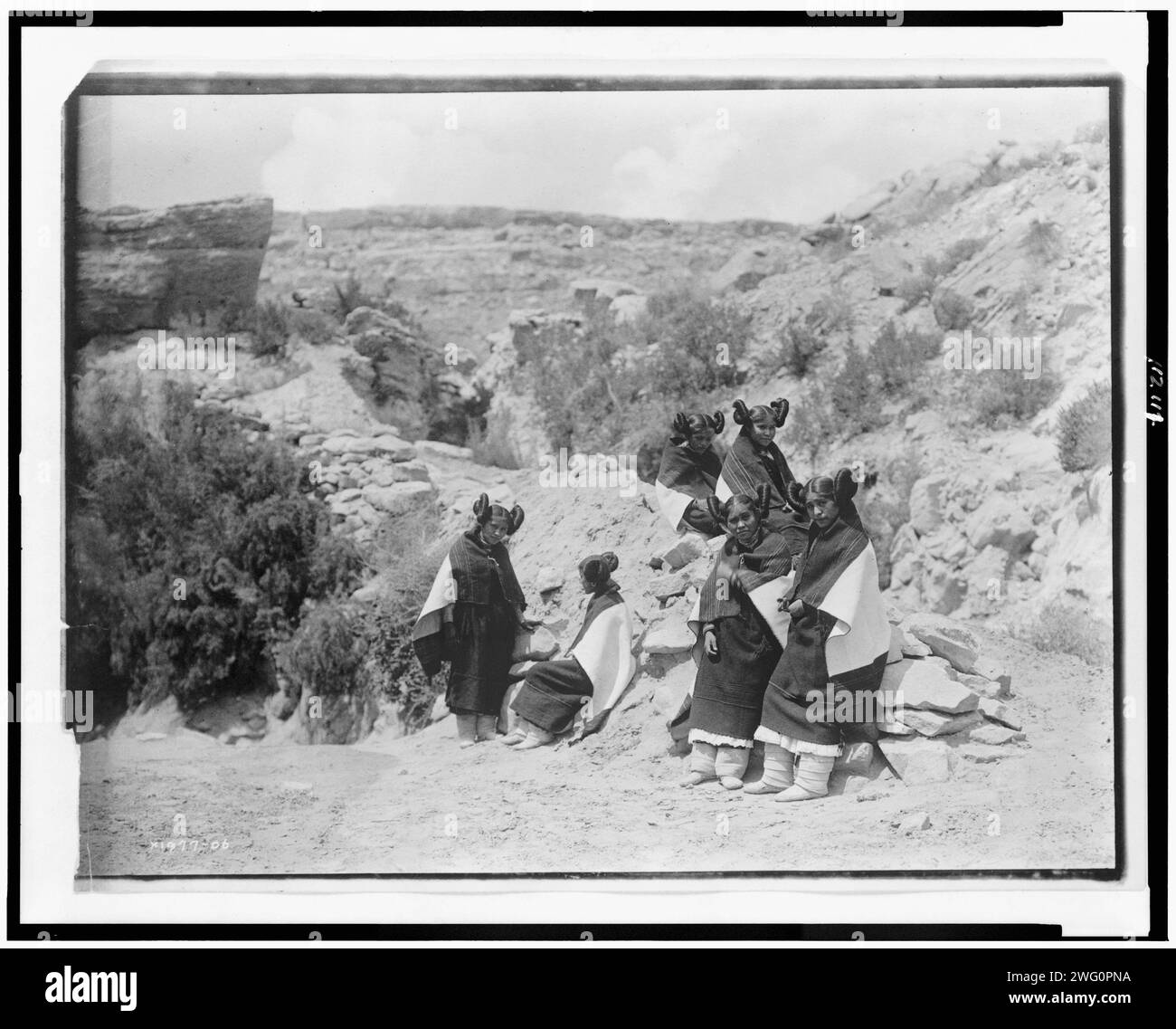 East Mesa girls-Hopi, c1906. Stock Photohttps://www.alamy.com/image-license-details/?v=1https://www.alamy.com/east-mesa-girls-hopi-c1906-image595004854.html
East Mesa girls-Hopi, c1906. Stock Photohttps://www.alamy.com/image-license-details/?v=1https://www.alamy.com/east-mesa-girls-hopi-c1906-image595004854.htmlRM2WG0PNA–East Mesa girls-Hopi, c1906.
 Jar, c. 1890-1910. In the southwest, pottery-making achieved two peaks. The first was in the late archaeological period, and the second was brought about by modern Pueblo women starting in the late 1800s. One of these women was the legendary Nampeyo, who revived fine Hopi potterymaking after a long period of artistic deterioration. To do so, she sometimes adapted the designs and shapes of Sityaki-style ceramics, which she and her husband found at ancient ruins. Comparison of this vessel to the Sityaki example to the left reveals Nampeyo’s relationship to the past. Stock Photohttps://www.alamy.com/image-license-details/?v=1https://www.alamy.com/jar-c-1890-1910-in-the-southwest-pottery-making-achieved-two-peaks-the-first-was-in-the-late-archaeological-period-and-the-second-was-brought-about-by-modern-pueblo-women-starting-in-the-late-1800s-one-of-these-women-was-the-legendary-nampeyo-who-revived-fine-hopi-potterymaking-after-a-long-period-of-artistic-deterioration-to-do-so-she-sometimes-adapted-the-designs-and-shapes-of-sityaki-style-ceramics-which-she-and-her-husband-found-at-ancient-ruins-comparison-of-this-vessel-to-the-sityaki-example-to-the-left-reveals-nampeyox2019s-relationship-to-the-past-image330099627.html
Jar, c. 1890-1910. In the southwest, pottery-making achieved two peaks. The first was in the late archaeological period, and the second was brought about by modern Pueblo women starting in the late 1800s. One of these women was the legendary Nampeyo, who revived fine Hopi potterymaking after a long period of artistic deterioration. To do so, she sometimes adapted the designs and shapes of Sityaki-style ceramics, which she and her husband found at ancient ruins. Comparison of this vessel to the Sityaki example to the left reveals Nampeyo’s relationship to the past. Stock Photohttps://www.alamy.com/image-license-details/?v=1https://www.alamy.com/jar-c-1890-1910-in-the-southwest-pottery-making-achieved-two-peaks-the-first-was-in-the-late-archaeological-period-and-the-second-was-brought-about-by-modern-pueblo-women-starting-in-the-late-1800s-one-of-these-women-was-the-legendary-nampeyo-who-revived-fine-hopi-potterymaking-after-a-long-period-of-artistic-deterioration-to-do-so-she-sometimes-adapted-the-designs-and-shapes-of-sityaki-style-ceramics-which-she-and-her-husband-found-at-ancient-ruins-comparison-of-this-vessel-to-the-sityaki-example-to-the-left-reveals-nampeyox2019s-relationship-to-the-past-image330099627.htmlRM2A519CB–Jar, c. 1890-1910. In the southwest, pottery-making achieved two peaks. The first was in the late archaeological period, and the second was brought about by modern Pueblo women starting in the late 1800s. One of these women was the legendary Nampeyo, who revived fine Hopi potterymaking after a long period of artistic deterioration. To do so, she sometimes adapted the designs and shapes of Sityaki-style ceramics, which she and her husband found at ancient ruins. Comparison of this vessel to the Sityaki example to the left reveals Nampeyo’s relationship to the past.